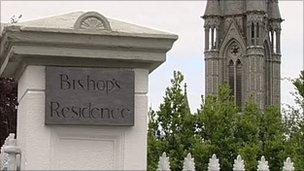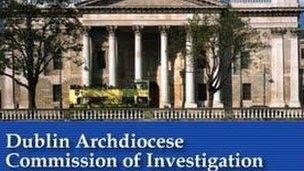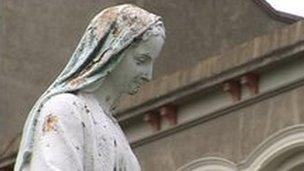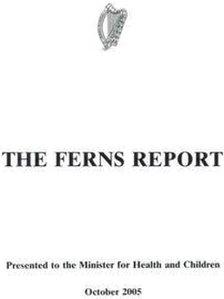Significant abuse reports and their findings
- Published
The report into historical sex abuse in the Roman Catholic Diocese of Raphoe, external is the latest review conducted by the National Board for Safeguarding Children in the Catholic Church. This board was set up because of various child abuse scandals and is now reviewing every diocese in the country, examining what was done wrong in the past. BBC News Online takes a look at other significant reports and their findings.
CLOYNE REPORT

The Bishop's Residence in Cloyne, County Cork
The Cloyne Report, external investigated the Diocese of Cloyne, external which covers most of mid, east and north Cork, in the Republic of Ireland.
It was led by Judge Yvonne Maguire and examined child safeguarding measures within the diocese up until 2009. It was published on 13 July 2011.
Commissioners were not tasked with establishing whether child sexual abuse took place or whether there was a basis for suspicions or concerns.
Instead, the inquiry was ordered to look at child protection practices in the diocese and how it dealt with complaints against 19 priests made from 1996, the year in which the Catholic Church put in place detailed procedures for dealing with child sexual abuse.
The report found that Bishop John Magee - who stood down in March 2009 after serving as bishop of Cloyne since 1987 - falsely told the government and the health service that his diocese was reporting all abuse allegations to authorities.
It also found that the bishop deliberately misled another inquiry and his own advisers by creating two different accounts of a meeting with a priest suspected of abusing a child, one for the Vatican and the other for diocesan files.
It discovered the diocese did not implement procedures set out in the Church protocols for dealing with allegations of child sexual abuse.
DUBLIN ARCHDIOCESE (MURPHY) REPORT

The report into the child abuse within the Dublin diocese
The report of the Commission of Investigation into the Catholic Archdiocese of Dublin, external was set up in 2006 to investigate how Church and state authorities handled allegations of child abuse against 46 priests over a period from 1975 to 2004.
Also known as the Murphy Report,, external it was published in November 2009.
The damning report criticised the Catholic Church hierarchy for covering up the abuse.
It found that the Church placed its own reputation above the protection of children in its care and that state authorities facilitated the cover-up by allowing the Church to operate outside the law.
One priest admitted to sexually abusing over 100 children, while another accepted that he had abused on a fortnightly basis throughout his 25-year ministry.
Of the 46 priests examined, 11 pleaded guilty to, or were convicted in the criminal courts, of sexual assaults on children. There was one clear case of a false accusation of child sexual abuse.
The report found Dublin Archdiocese's pre-occupations in dealing with cases of child sexual abuse, at least until the mid 1990s, were the maintenance of secrecy, the avoidance of scandal, the protection of the reputation of the Church, and the preservation of its assets.
All other considerations, including the welfare of children and justice for victims, were subordinated to these priorities.
RYAN REPORT

The Ryan Report took evidence from people who claimed to have been abused in Catholic-run institutions.
The Dublin Archdiocese report came six months after the publication of the Ryan report in May 2009.
The Ryan Report, external, also known as the Report of the Commission to Inquire into Child Abuse, caused widespread controversy over its findings that sexual and psychological abuse was "endemic" in Catholic-run industrial schools and orphanages in Ireland for most of the 20th Century.
The inquiry covered a 60-year-period from 1936.
It took submissions from 2,000 people who said they had suffered physical and sexual abuse while in the care of Catholic-run institutions.
The report proposed 21 ways the government could recognise past wrongs, including building a permanent memorial, providing counselling and education to victims, and improving Ireland's current child protection services.
FERNS REPORT

The Ferns Report was published in 2005
The 271-page Ferns Report was an Irish government inquiry into child abuse in the County Wexford Diocese of Ferns, external which was published in October 2005.
The two-year investigation was chaired by retired supreme court judge Frank Murphy.
It uncovered more than 100 allegations of sexual abuse by priests and said the allegations were made against 21 priests who had been working in the diocese between 1966-2002.
The report said police investigations into claims of abuse were inadequate.
It also criticised bishops in the diocese for failing to take basic precautions to protect children.
It said that between 1960 and 1980, the then bishop of Ferns, Donal Herlihy, treated child sexual abuse in his diocese as an "exclusively moral problem".
Priests who were accused of abuse were transferred to a different post or different diocese for a time, but were later returned to their former position, the report found.
A second senior clergyman, Bishop Brendan Comiskey, was also heavily criticised.
The report stated he had consistently failed to have priests step aside because he considered it unjust as allegations of abuse were not substantiated.
- Published13 July 2011